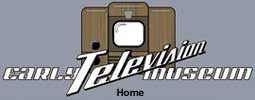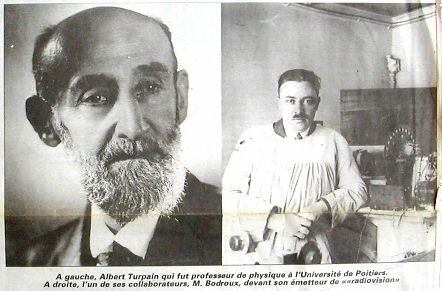 |
 |
Radiovision in Poitiers in 1933
Documentary source: Jean Christophe FILLOUX

 |
 |
Radiovision in Poitiers in 1933
Documentary source: Jean Christophe FILLOUX

(Note: this article gives a good account of the state of the nascent television and the difficulties encountered during the first experiments.)
Experiences at Poitiers. (Article in magazine La Gran'Goule', October 16, 1933).
The transmission of images by means of electric waves constitutes Radiovision; It is commonly called Television, a name that is less just because it etymologically means to see in the distance.
The transmission of images was made possible by the discovery of the photoelectric cell, which, when illuminated, modulates electrical energy from a battery or other generating source, with the intensity varying in proportion to the quantity of light received. It is the property of certain elements, especially the alkali metals, potassium, sodium, rubidium, and cesium, which are used in the cells, to emit negative electricity when they are subjected to light radiation. When given photons (particles of light), they make electrons (particles of electricity).
In order to transmit any object or scene in television, the light, before reaching the cell must explore its subject, that is to say, sweep in a very short time the various regions of it. Exploration is most often carried out by a planar disk pierced with equidistant and equal holes (Nipkow disc), which may be provided with convergent lenses (Brillouin disc), arranged not on a circumference but in a spiral, and rotating at a constant speed. There are, consequently, rapid successions of illumination and darkness for the cell, and as the illumination is of variable intensity, the currents which result from it in the circuit also vary. The apparatus further comprises, as in radiotelephony, of amplifiers and a producer of modulated waves.
For reception, a special apparatus is used comprising of a neon lamp connected to the last stage of an amplifier, the lamp whose brightness follows the variations of the modulated current which passes through it and whose electrodes are parallel metal plates. In front of the neon lamp, a disk identical to that used for transmission, rotates with the same speed. Its holes produce parallel lines on the screen. The luminous points are restored in space in the same way that they were taken at the transmission. The image is small and bright orange and a magnifying glass is used to view it.
This allows only one person to watch. Attempts have been made to allow collective viewing of television. Several solutions have been proposed; One of them replaces the neon lamp by an apparatus called the Kerr cell, through which passes a ray of white light, coming from an external source. The cell modulates the intensity of the light source, which then passes through the holes of the moving disk before spreading on a vertical plane screen. The image enlarged by the projection is less clear; It stands out in black and white on a dimly lit background.
However, whatever the method employed, the formation of a suitable image requires that the two discs rotate at the same speed and that at each instant their corresponding holes are identically arranged with respect to the sources Light. In order to achieve this result, a sychronizing device (synchronous motor) mounted on the axle which carries the disk, is supplied either from the alternating current of the mains, when the same electrical distribution serves the camera, or by a periodic current incorporated in the transmitted signal.
Theoretically, synchronization is achieved satisfactorily when the transmitter and the receiver are powered by the same mains grid. That is why, in London and its suburbs, the owners of televisions receive, in suitable conditions, the broadcasts traansmitted by the Broadcasting Corporation.
But when the transmitting and receiving stations, separated by a large distance, are connected to different electrical networks, this is not the case. Synchronism is often painful to get: the images move quickly on the screen, from the bottom up, or vice versa. The instrument should then be carefully adjusted to ensure proper stability for observation. It is for this reason that companies producing television receivers, when they do public demonstrations in the vicinity of the transmitting station, transmit by wire rather than over the air, and avoid demonstrations in remote towns.
While an ordinary TSF device can receive all major radio stations in Europe, a television set only receives the images corresponding to a given transmission system. Not all discs have the same number of holes:
Baird system................30 holes
Mihaly system...............48 holes
Barthélemy system..........78 holes
Their rotation speed may not be the same and the scanning of the scene to be transmitted is done in some cases horizontally, in others vertically. An apparatus adapted to the London programs, with vertical scanning, can not be used for reception of images sent using another system, Paris or Berlin.
Moreover, television devices, which are not very selective, are sensitive to certain noise emissions which disturb and even prevent their normal operation. For this reason, the transmission of the images must take place while the stations of sound of neighboring wavelengths are usually silent: that is why London operates very late in the evening.
The more holes the disc used at the transmitting station has, the better the scanning of the scene to be transmitted, and the more noticeable the details are: with 180 holes the results are excellent. In the Baird process used by London, the number of holes being only thirty, the images observed are coarse; but as the characters move on the receiver screen, observing them at a suitable distance some of the defects disappear.
Whatever the prospectuses of some companies say, television is not at the moment available to everyone. Practically, it can not provide satisfactory pictures to people living far from a transmitter, unless they are skilled experimenters. This new use of electric waves is still in childhood, and if the results obtained are extremely interesting for the scientist, they do not make it possible to foresee when the dream of many people will be realized: free cinema at home, Telecine
Experiences of BODROUX and RIVAULT
He was confident in the assertions of several scientific authors on the ease of reception of television, Daniel BODROUX, a member of the staff of the Faculty of Science, the chief of practical chemistry, who had long been familiar with all aspects of radiotelephony, had a receiver apparatus, with neon lamp and Nipkow disk adapted to the London programs (30 holes, rotation speed: 750 revolutions per minute) in his laboratory. But the results did not meet his expectations. Having observed some anomalies in the images, he joined with one of his young colleagues, M. RIVAULT, assistant of physics.
The reassembly of the receiver, carefully studied, was perfected, and the two experimenters first obtained clear images, framed in a rectangle, 1 cm. 5 in width and 3 cm. To see the details they observed with a strong magnifying glass. Then they thought of projecting the images on a screen of exercises performed on a London stage.
They succeeded in this (the illuminated rectangular surface being at first 15 cm by 35 cm.), And they combined the projection apparatus with a radio apparatus so that, on seeing a singer, the melody could be heard, According to the dances of a dancer or a dancer, one could hear at the same time the music rhythmizing their steps.
But with the neon lamp, the illumination of the screen was very dim. To make it more lively, they replaced the neon lamp with a ray of light passing through a Kerr cell. The proportion of modulated light rose to 14 per cent, and by modifying the optical system used for projection, the experimenters gradually enlarged the illuminated surface (and consequently those of the images) to 24 x 58 square centimeters.
The assembly of the apparatus in its final form was completed in early April, and observations began. But, whether coincidentally or deliberately, since the advent of the Hitler regime, the Frankfurt station operates until midnight on the days when images are broadcast in London between 11 pm and 11.30 pm. while sometimes it remains silent on other days from 11 pm. The wavelength of this station being close to that used for television, the images are scrambled attenuated, or rendered invisible on the screen by bands or arabesques of variable shapes, as a result of the reception of sounds. So that it is only at rare intervals, in a period of silence separating two parts of the program, or when the German broadcast is attenuated by the phenomenon of fading, that the figures of the artists appear more or less clearly.
To preserve a lasting memory of these scenes which take place on a distant theater, MM. Daniel BODROUX and RIVAULT have built an ingenious device that allows each of them to take a series of photographs. The exposure time for each photograph is approximately one-twelfth of a second and corresponds to a complete revolution of the disc. These photographs naturally reproduce the imperfections of the images, imperfections which are caused by the conditions of the transmission (disc with small number of holes) and the interference produced by the German sound transmission. The sounds, after their visual transformations by the reception apparatus.
The disturbance caused by noise that can not be avoided at reception, the fact that the London station is broadcasting at a late hour and only on certain days, make observations very difficult. In order to work under normal conditions, Daniel BODROUX and RIVAULT thought of making the pictures themselves. But it requires a special and expensive apparatus; The latter is in the process of being developed, thanks to Professor Turpain, who, after Hertz had discovered the electric waves, was one of the first to undertake their study and to advocate their use.
My excellent colleague is very interested in the work of our two collaborators: he has placed at their disposal material from his laboratory and part of the credits, modest alas! For scientific research. An imaging device will soon operate in a room at the Institute of Physics, and the transmission of these images, their long-range reception, and various related questions will be studied seriously.
If thisexperimental research leads to the results which MM. Daniel BODROUX and RIVAULT, they will help to raise awareness of our Faculty of Science and the good reputation of our old University.